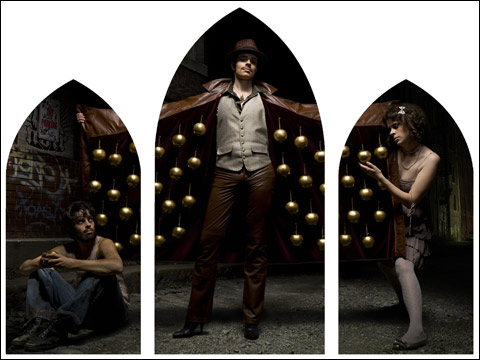Bradford's art blasts off when he switches to sprawling, chaotic compositions from salvaged advertisements (the ad images are often obscured) around 2004. His 16-foot-wide collage Potable Water (2005) features horizontal stripes of silver and sky-blue paper topped with squares of fluorescent orange, pink, and green like musical notes shimmering over a melody. After Katrina, Bradford made Mississippi Gottdam (2007), whose title comes from Nina Simone's 1964 civil-rights song. It features wavy lines gouged into a surface built up from comic books (The Hulk, Green Arrow) covered with silver wrapping paper. Is there something in here about drowned heroes? A Truly Rich Man Is One Whose Children Run into His Arms Even When His Hands Are Empty (2008) seems to gaze down at a grid of streets swamped in blackness. "The reason I use paper is because paper is so unforgiving," Bradford says. "It's opaque. It doesn't give it up. You've really got to struggle with it to lift it."
Bradford's more head-on engagements with race, violence, and struggling to make a living aren't as satisfying. Sometimes the problem is that his references are obscure. How is the map-like composition of Scorched Earth (2006) supposed to bring to mind a 1921 Oklahoma race riot? Text pieces built from posters for a "Gun Show" or "Propane delivered to FEMA trailers" or "Is this child yours? DNA testing" are striking subjects but lack the mystery often needed to draw us in. And his layering and abrading doesn't necessarily chime with what the words say.
Bradford's brilliance resides most in his crafty, physical ingenuity. In his work from the past year, he seems to be testing new techniques, like building up paper over strings to create thick, cracked, frosting-like surfaces. He frequently gets compared to Jackson Pollock or Mimmo Rotella, an Italian who made art from layered and ripped advertising posters in the 1950s. But I keep thinking of Matt McCormick's 2001 documentary film The Subconscious Art of Graffiti Removal, which half-jokingly compares the patchwork rectangles of painted-over graffiti to Mark Rothko paintings, and the work of Los Angeles artist Shepard Fairey. On streets or in galleries (like the ICA last year), Fairey's art imitates the layering and glorious rusty decay of the urban landscape. He rips his own posters and pastes them one atop another to imitate that lovely city patina that speaks of the jostling voices, the hurly-burly, the endless cycles of creation and destruction and rebuilding of metropolises. That is Bradford's subject as well.

GOLDEN DELICIOUS: Triiibe’s metaphors can be clichéd, but their stagecraft has grown ever more astonishing. |
The Boston artist gang Triiibe begin with an irresistible idea. Identical triplet sisters Alicia, Kelly, and Sara Casilio collaborate with a National Geographic photographer to stage strange visions: worried parents in their sullen teen's bedroom; a pregnant woman in an electric chair flanked by a minister and a guard; a couple in front of a photo of their soldier son. The images are well executed, but the allegories feel somewhat simplistic. And photographs sap the marvel of the set-up — the gender-bending sisters play all the characters, but we don't believe they're actual triplets because we suspect Photoshop tricks.